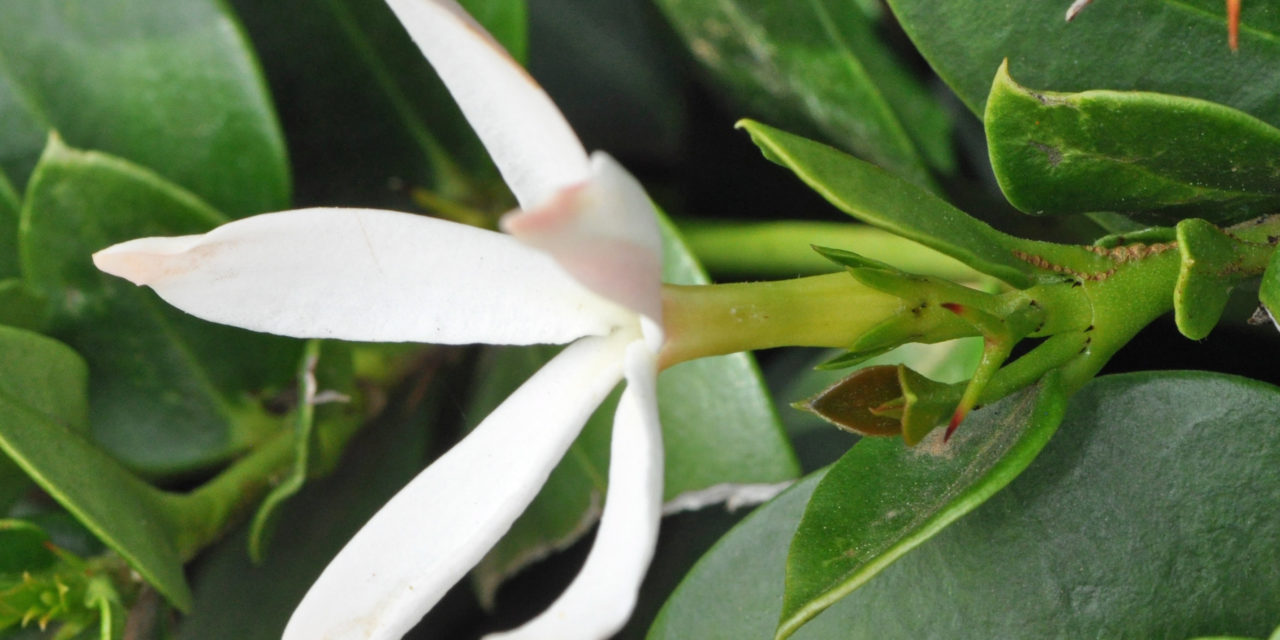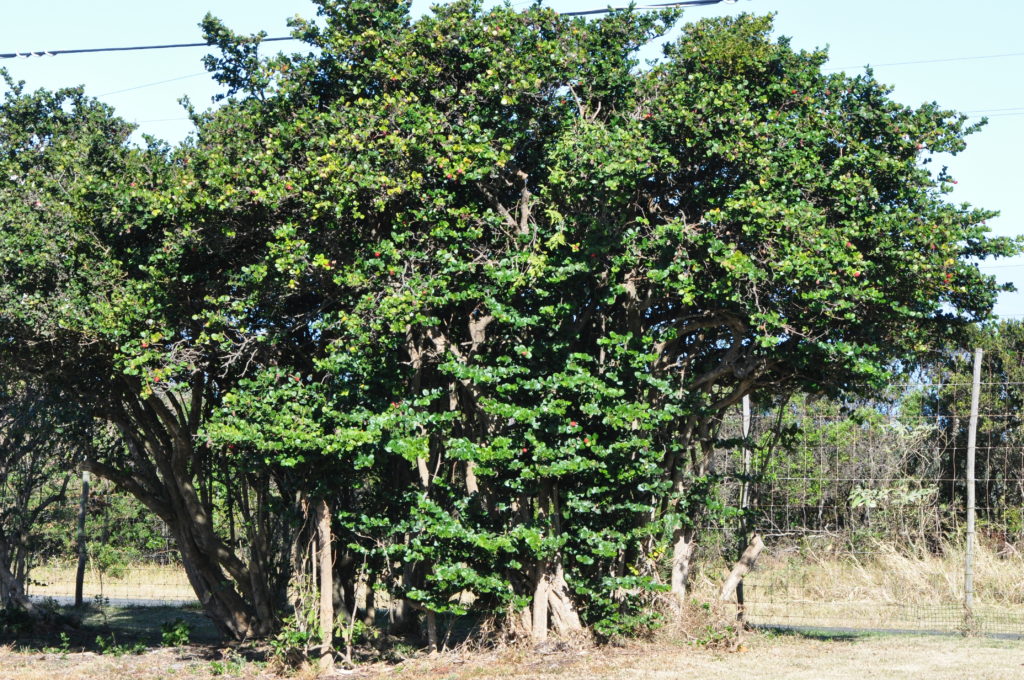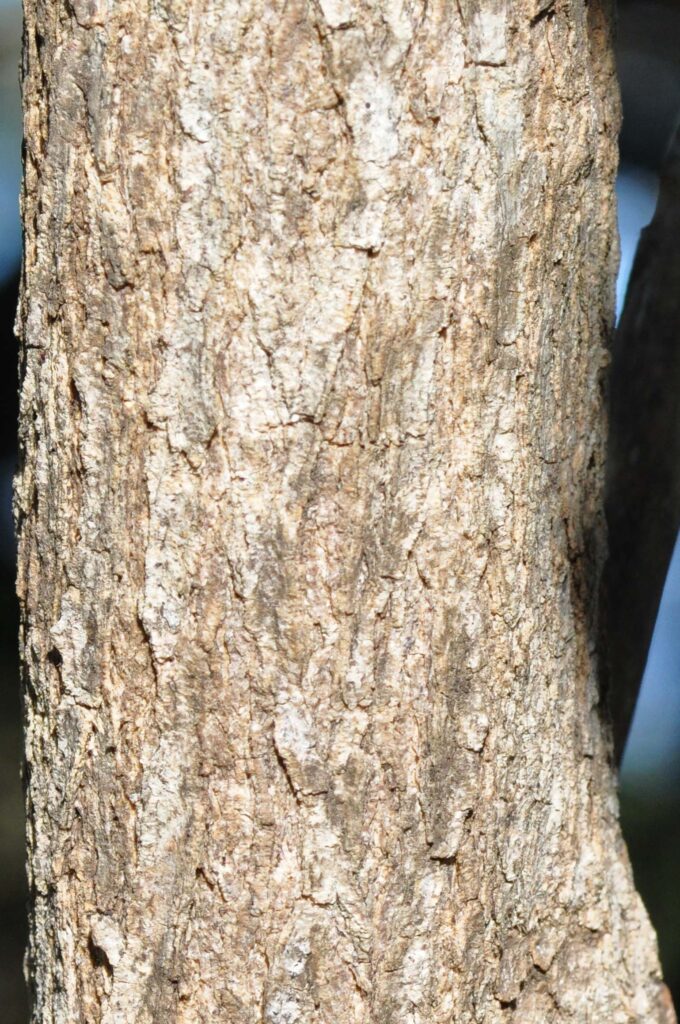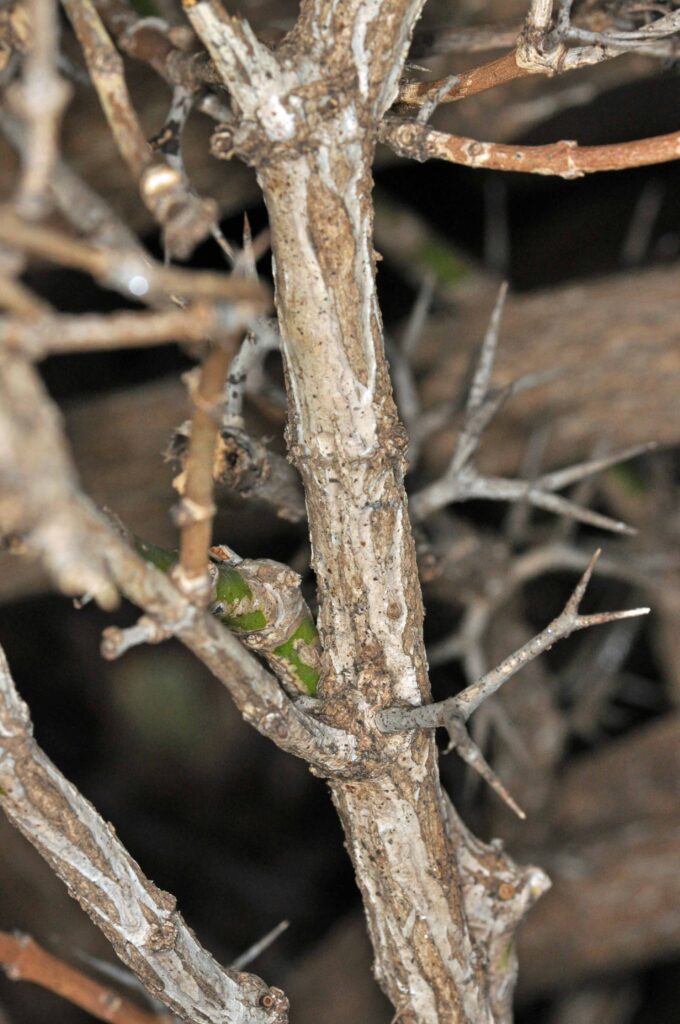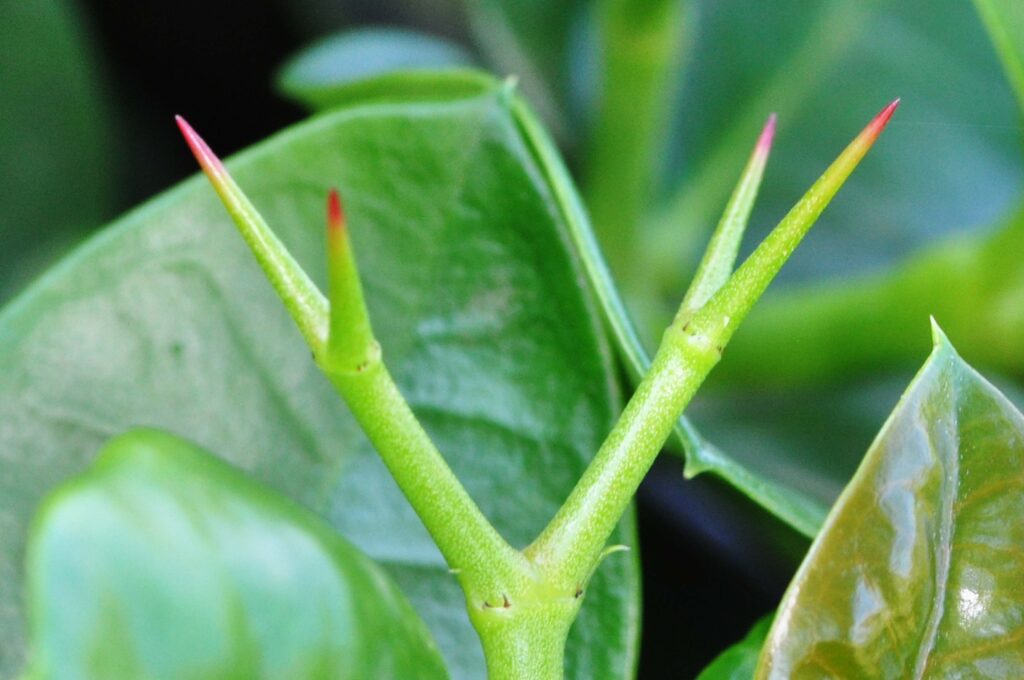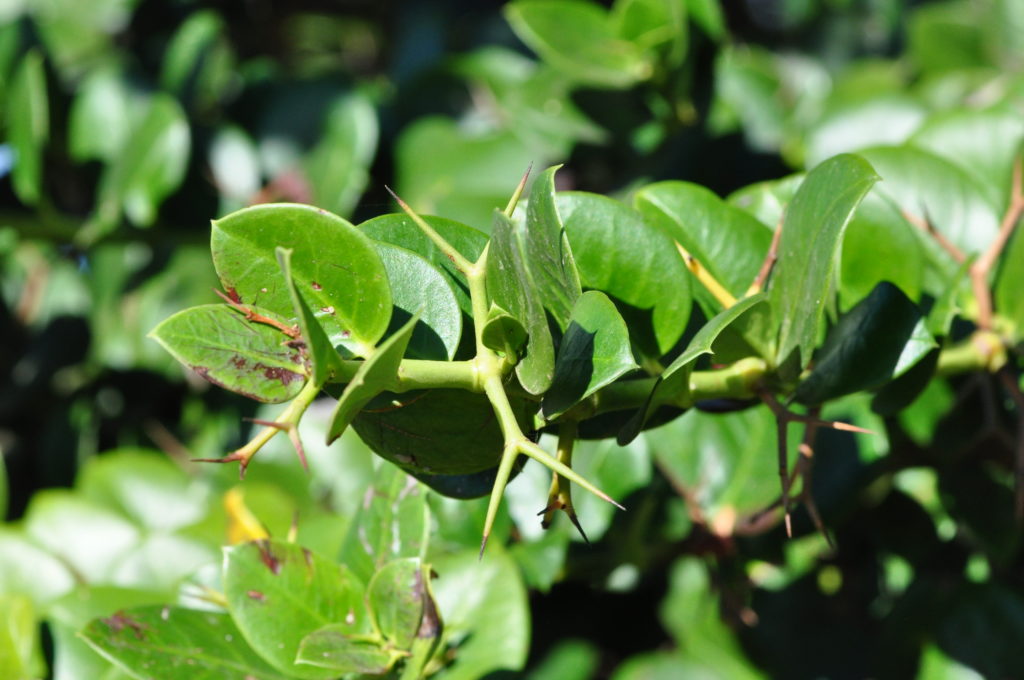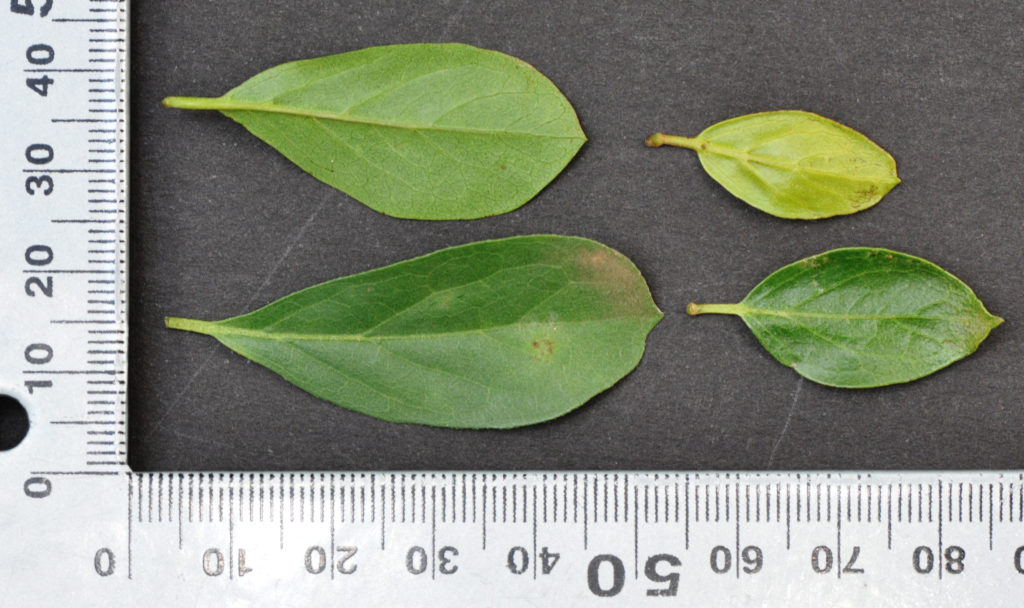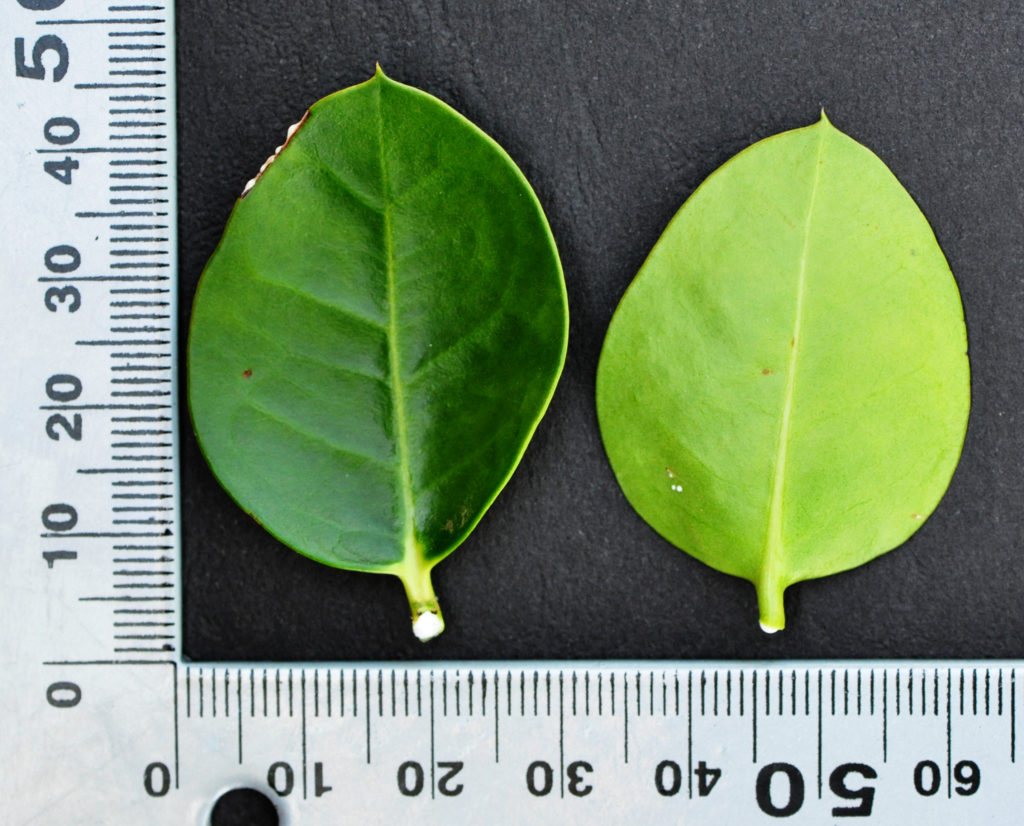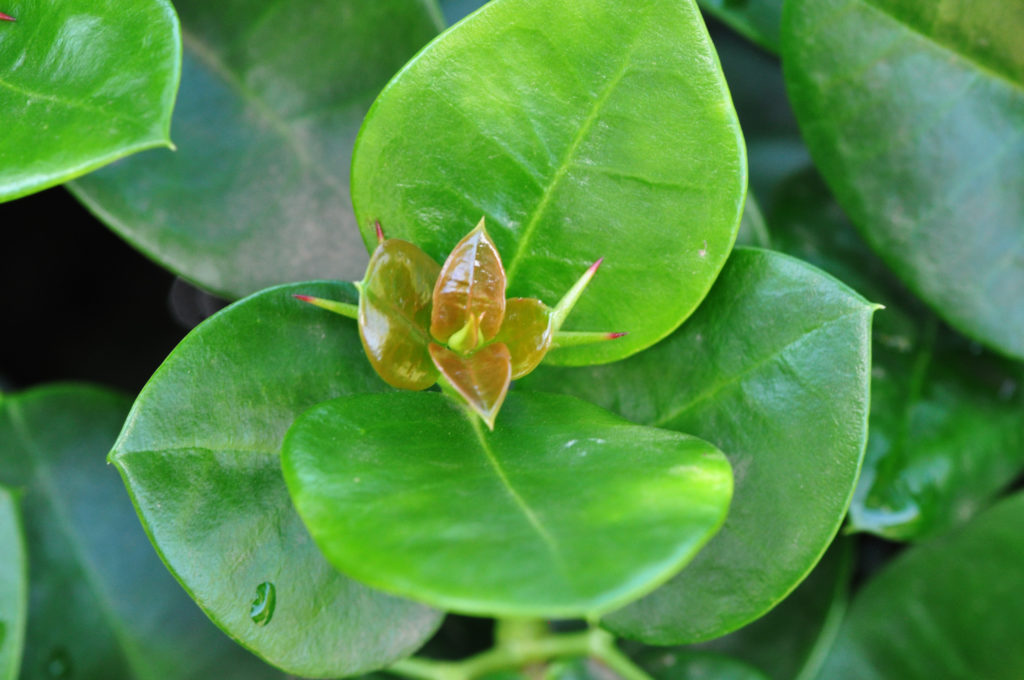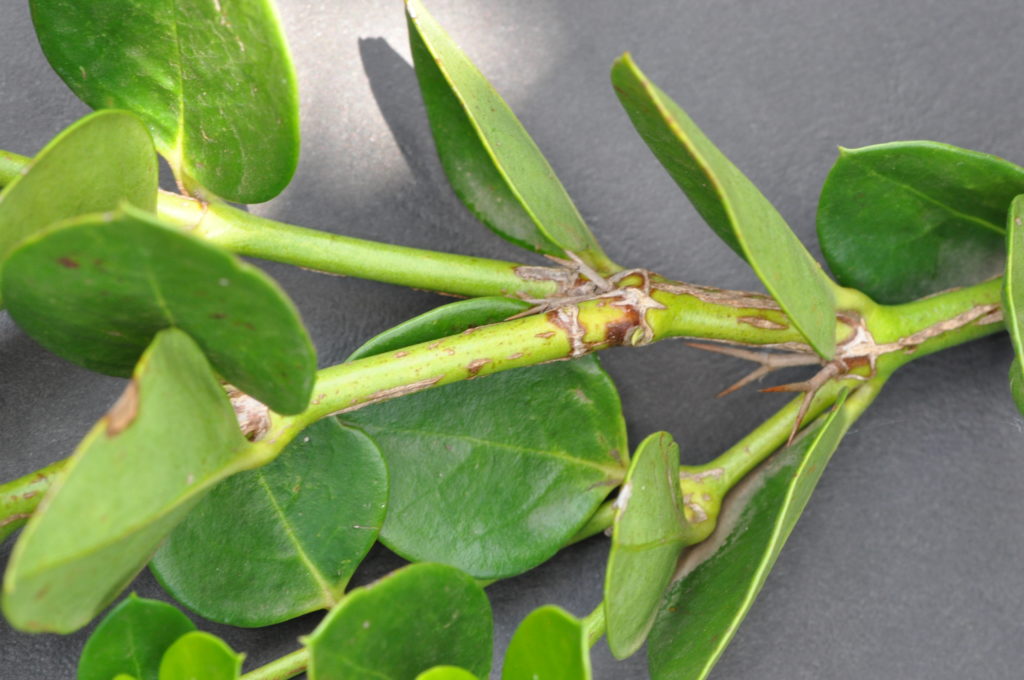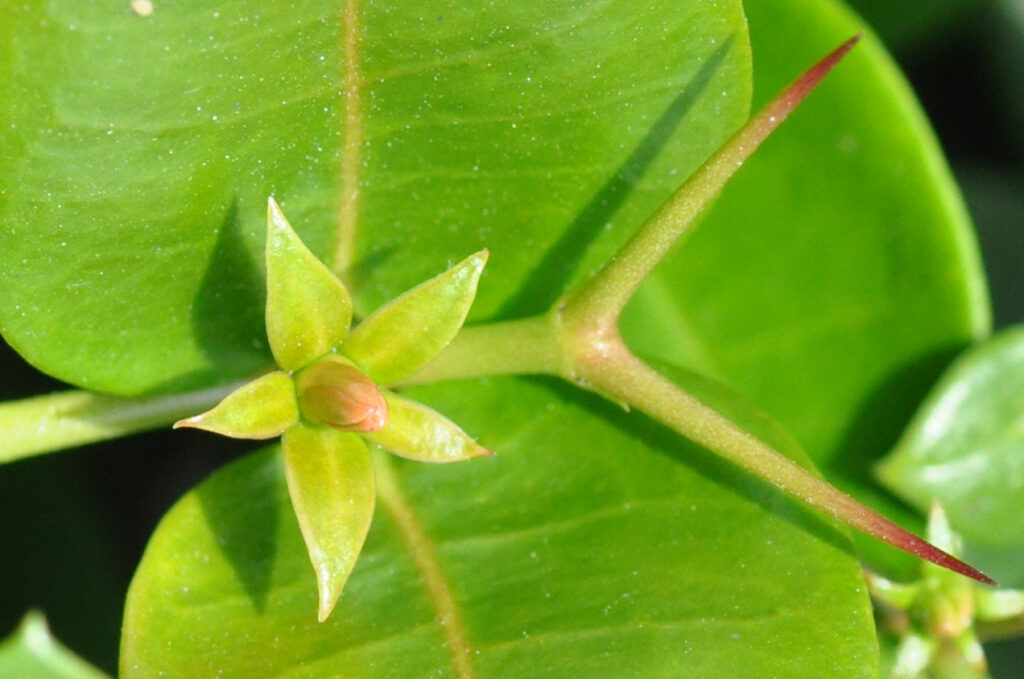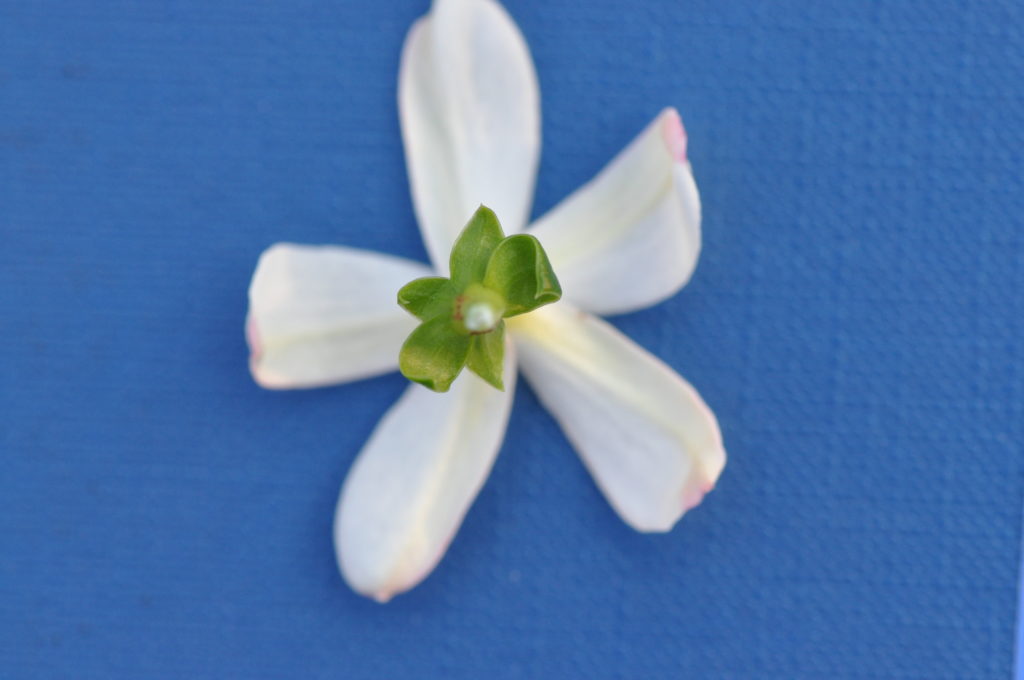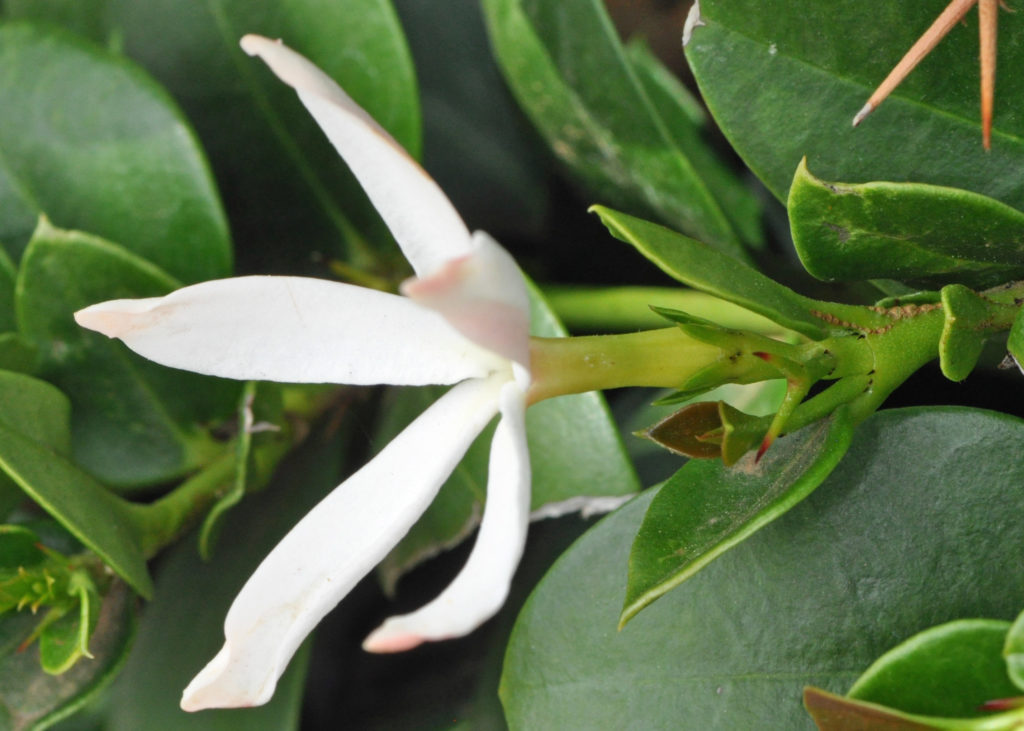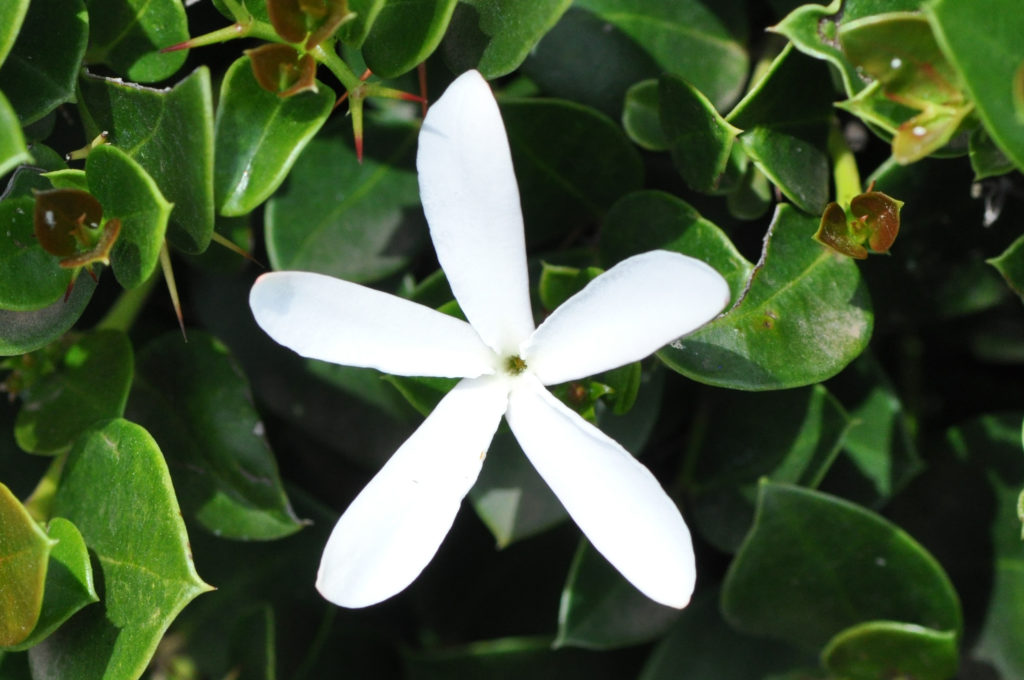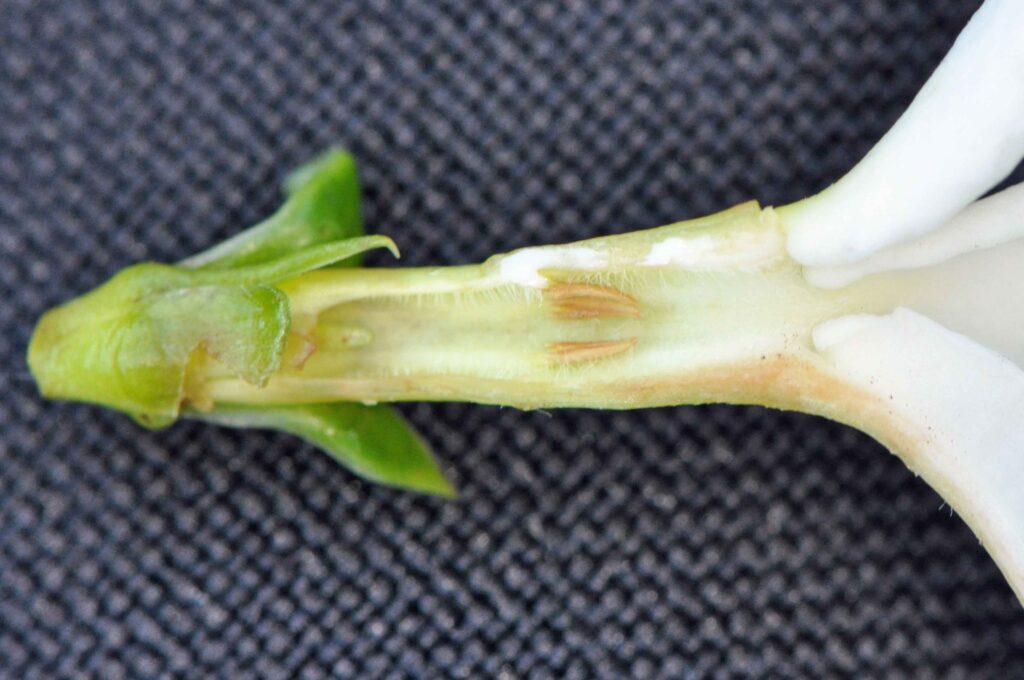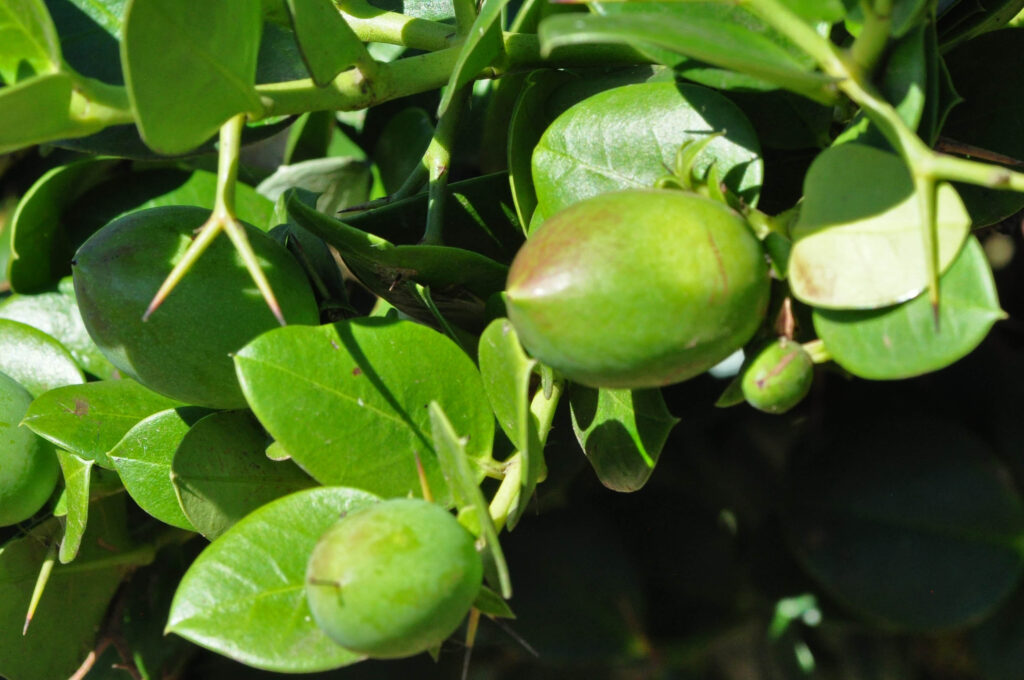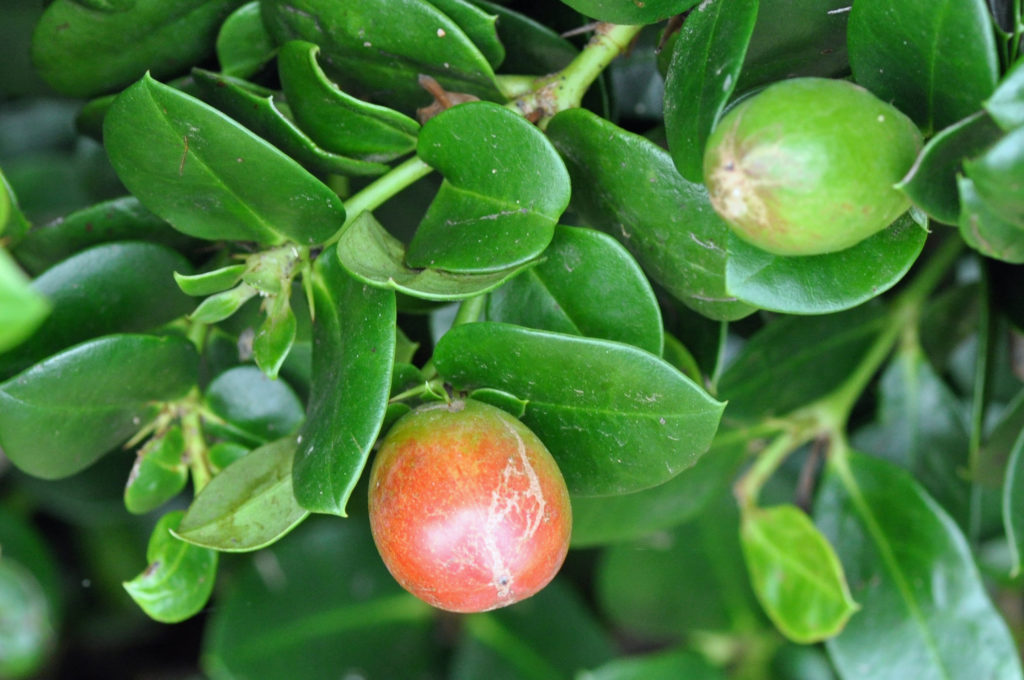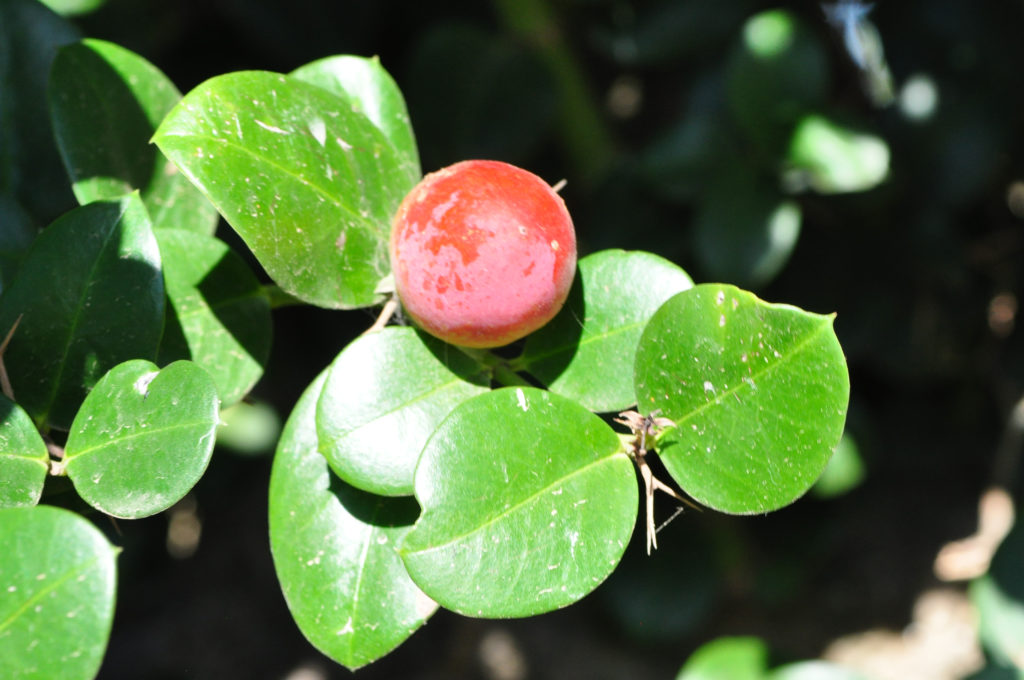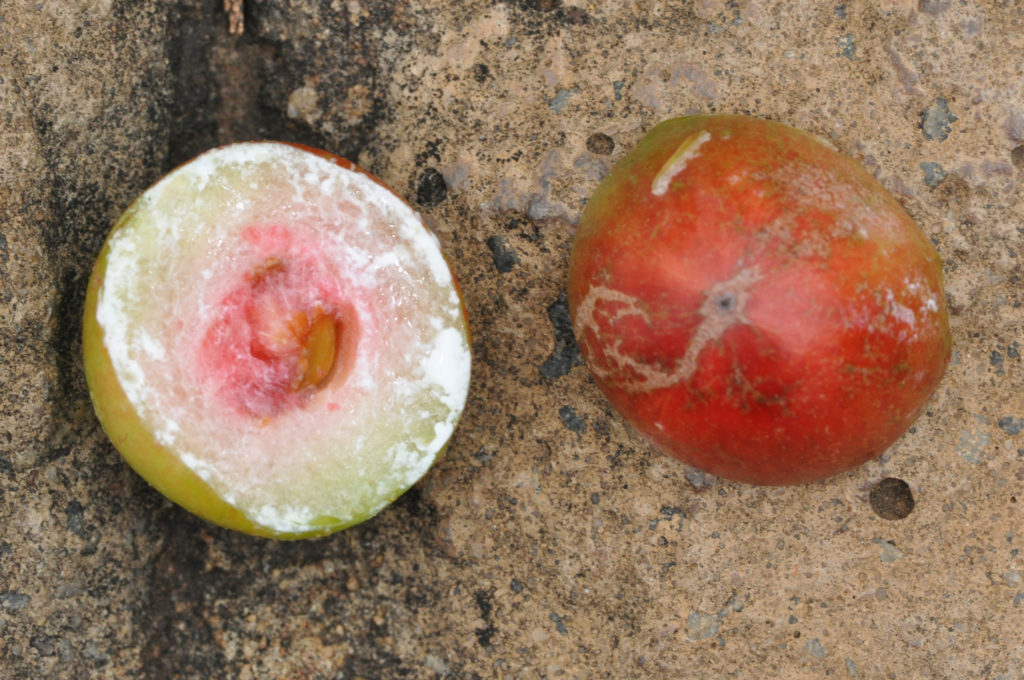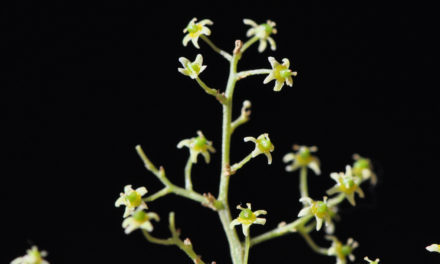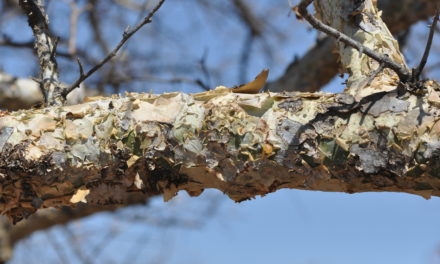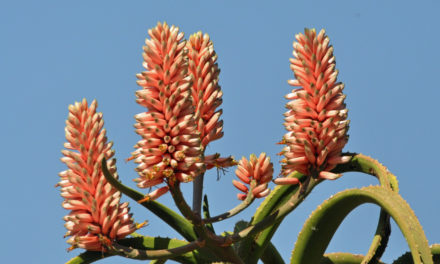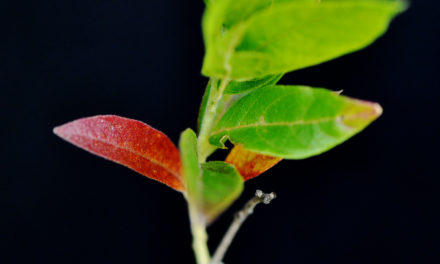General Info – summary.
This Tree is up to 5m high or a much-branched shrub. Distinctive paired, Y-shaped equal spines up to 4,5 cm long. Non-toxic milky latex are present. Evergreen, leathery, hairless, simple Leaves are mucronate. Bisexual, actinomorphic, 5-merous white Flowers have a corolla + tubular base & imbricated lobes. Apiculate anthers don’t protrude beyond the mouth. Ovary is superior. Edible Fruit is a fleshy berry.
Description.
Carissa macrocarpa.
Previous Names: Ardunia macrocarpa, Carissa grandiflora, Jasminoenerium grandiflorum.
SA Tree No. 640.3.
Common names: (Afr) Amatoengoela, Amatungula, Groot Noem-noem, Grootnoem-noem. (Eng) Amatungulu, Big Num-num, Large Num-num, Natal Plum. (isiXhosa) Nmthungulu. (isiZulu) Umthungulu. (siSwati) Umthungulu.
Family: Apocynaceae (Oleander or impala lily: Adenium multiflorum family). This family includes the exotic genera Oleander and Plumeria (Frangipani). Indigenous genera containing trees on this site include Acokanthera, Adenium, Carissa, Rauvolfia and Tabernaemontana. Currently the family has 366 genera and in excess of 5 000 species. In South Africa, there are 90 genera and about 700 species. All have milky or clear sap. The simple, entire and pinnately veined Leaves are usually opposite and may have stipules situated between the petiole and the stem. The Inflorescence is usually a cyme (a broad, more or less flat-topped, determinate flower cluster, with central flowers opening first). The regular and bisexual Flowers are usually bracteate. The Calyx has 4-5, usually free sepals and the 4-5 Petals are joined – at least at the base of the staminal column. A corona (an extension) is often present either on the corolla, or on arising from the base of the staminal column. The 4-5 Stamens are variously located and have anthers with 2 pollen sacs. The superior to half-inferior Ovary has 2 carpels. Fruit is various. The often-compressed Seeds may have a tuft of silky hair at the micropylar end. The micropyle (a small opening in the surface of an ovule, through which the pollen tube penetrates) is often visible as a small pore in the ripe seed. During germination, the seedling’s radicle – embryonic root – emerges through the micropyle).
Name derivation: Carissa from Corissa – the name given to an Indian species of the same genus. It is derived from Sanskrit (primary sacred language of Hinduism). macrocarpa – refers to the large fruit (Greek).
Conservation: National Status: L C. (Least Concern). Assessed: 2018 (L. von Staden).
Tree
This small evergreen Tree is up to 5m high and is usually about the same width (photo 442). It is often a densely twiggy, much-branched, shrub. All parts may exude a white, milky non-toxic latex. Young stems are green (photo 440). The grey/brown rough Bark becomes wrinkled into longitudinal ridges or channels (photo 441). Sharp woody, Spines are once or twice forked (photo 893). These paired spines have the same length. They are Y-shaped, opposite, rigid and may initially be red tipped (photo 893). Spines initially arise at the tip of a shoot and each spine is up to 4,5cm long. These persistent spines are still visible on older branches (photo 570).
- 442 2017/07./11 Kwelera NBG. Photo: David Becking.
- 441 2017/07/11 Kwelera NBG. Photo: David Becking.
- 570 2017/10/24 Walter Sisulu NBG. Photo: David Becking.
- 893 2014/11/02 Walter Sisulu NBG. Photo: David Becking.
- 440 2017/07/11 Kwelera NBG. Photo: David Becking.
Leaves
This evergreen plant has leathery, hairless Leaves that are simple (has a single blade which may have incisions that are not deep enough to divide the blade into leaflets). The leaves are broadly ovate (egg-shaped – photo 409), obovate (photo 150) or oval to almost round and up to 7 x 5cm. The Margin is entire (with a continuous margin, not in any way indented) and the Petiole (leaf stalk) is up to 5mm long and grooved on top (photo 409). Lateral veins may protrude slightly above (photo 409). The Midrib (the main rib of a leaf or leaf-like part, a continuation of the petiole) protrudes below. Leaves are shiny dark green above and lighter below (photo 409). New leaves are a copper colour (photo 895). The Apex is tapering to rather rounded and sharply mucronate (ending abruptly with a distinct hair like tip – photo 409). The Base is square, rounded or tapering. Axillary glands are conspicuous. A harmless white Latex is present (photo 409) – unlike the very toxic latex present in species of Acokanthera (in the same family – also on this website.
- 150 2014/12/02 Walter Sisulu NBG. Photo: David Becking.
- 409 2014./0.2/8 Walter Sisulu NBG. Photo: David Becking.
- 895 2014/11/25 Walter Sisulu NBG. Photo: David Becking.
- 147 2014/12/02 Walter Sisulu NBG. Photo: David Becking.
Flowers
The conspicuous white, 5-merous Flowers may be tinged with pink (photo 366 & 369 – the exterior views of new and old petals). Flowers are up to 3,5cm wide and solitary, in terminal clusters or at the base of the spines. They have a scent similar to orange blossoms and are actinomorphic (Regular, symmetrical. Flowers are vertically divisible into similar halves by more than 1 plane passing through the axis). The Calyx (photo 366 & 586) is small, 5-lobed and imbricate (having regularly arranged, overlapping edges, as roof tiles). The Corolla is gamopetalous (united; joined petals at least at the base) and tubular (photo 369). It is up to 1,4cm long with a hairy interior (photo 408). From this tube, the 5 spreading lobes extend laterally. Each is up to 3,1cm long. The bases of the lobes are imbricate – overlapping on one side (photo 367). As a result, a picked flower will rotate, if carefully held then blown from the top. Flowers may develop close to the Y-shaped spines, or terminally. They may also be in small clusters. The 5 Stamens are attached to, and alternate with, the petals but do not protrude above the corolla tube (photo 408). They are epipetalous (borne on or arising from the petals or corolla). The Filaments are short and slender, and the Anthers are 4-locular and apiculate (ending in a short, sharp, flexible point – photo 408). No Disc (a more or less fleshy or elevated development of the receptacle) is present. There is a single Pistil (a unit of the Gynoecium, the female element of the flower, composed of the Ovary, Style and Stigma) and the entire Ovary is superior. (Most of the year).
- 366 2015/09/15 Walter Sisulu NBG. Photo: David Becking.
- 568 2017/10/24 Walter Sisulu NBG. Photo: David Becking.
- 369 2015/09/15 Walter Sisulu NBG. Photo: David Becking.
- 367 2015/09/15 Walter Sisulu NBG. Photo: David Becking.
- 408 2017/10/10. Walter Sisulu. Photo: David Becking.
Fruit
The large, ovoid, fleshy Fruit is a thin-skinned berry (pulpy, indehiscent fruit like a grape or tomato) that is up to 5 x 3,5cm. The initially green fruit (photo 439) matures to a red colour (photo 845) and may have a white bloom (photo 438). In this photo Stigma remains are visible. The fruit contains up to 4 thin, flat and oval to irregularly shaped Seeds (photo 848). (Sep-Mar).
- 439 2017/07/11 Kwelera NBG. Photo: David Becking.
- 845 2017/02/07 Walter Sisulu NBG. Photo: David Becking.
- 438 2017/07/11 Kwelera NBG. Photo: David Becking.
- 848 2017/02/07 Walter Sisulu NBG. Photo: David Becking.
Distribution & Ecology
This fast-growing plant is resistant to wind and sea-spray. It is common and often conspicuous in severe frost-free coastal areas including dunes and coastal forests and usually grows below 500m. The plant is cold (to -5°C), and drought resistant. It occurs naturally in the Eastern Cape, KwaZulu-Natal, Mozambique (up the coast from the southern border with South Africa), Zambia, Zimbabwe, Kenya and the Congo. Monkeys eat the Fruit. The fruit attracts many animals and birds. Pollination is by small beetles, hawk moths and other night-flying insects. Hawk moths (named because of their swift flight patterns) have a long proboscis, which they use in nectar feeding. The proboscis coils up – when not in use.
Ethnobotany
The whole Fruit is edible and tasty. The red flesh is tender and very juicy. It is rich in magnesium, vitamin C, phosphorus and calcium and makes an excellent jam. Each hectare of land can produce up to 3 tons of fruit annually. It grows easily from cuttings, which are initially slightly frost sensitive. Seeds can be used for propagation, but the cuttings are more successful. It is suggested that notching young branches, bending them down and leaving them in soil for 2 months will cause them to sprout. Thereafter it is planted in sand. Rooting should occur within a month. This plant can survive without fertilizer. Carissa macrocarpa has now been planted in Miami, Florida, California, Hawaii, Bahamas, Philippines, India, East Africa and Israel. It is also valued as a protective and ornamental hedge that can tolerates both salt spray and wind.
References
Boon, R. 2010. Pooley’s Trees of eastern South Africa. Flora and Fauna Publications Trust, Durban.
Burrows, J.E., Burrows, S.M., Lotter, M.C. & Schmidt, E. 2018. Trees and Shrubs Mozambique. Publishing Print Matters (Pty) Ltd. Noordhoek, Cape Town.
Coates Palgrave, M. 2002. Keith Coates Palgrave Trees of Southern Africa, edn 3. Struik, Cape Town.
Lawrence, G. H. M, 1951. Taxonomy of Vascular Plants. The Macmillan Company, New York. Tenth Printing 1965.
Palmer, E. & Pitman, N. 1972. Trees of southern Africa. Balkema, Amsterdam, Cape Town.
van Wyk, B. & van Wyk, P. 1997 Field guide to Trees of Southern Africa. Struik, Cape Town.
von Staden, L. 2018. Carissa macrocarpa (Eckl.) A.DC. National Assessment: Red List of South African Plants version 2020.1. Accessed on 2022/11/10.
https://en.wikipedia.org/wiki/Carissa_macrocarpa
https://hort.purdue.edu/newcrop/morton/carissa.html
http://www.plantzafrica.com/plantcd/carismac.htm
http://posa.sanbi.org/flora/browse.php?src=SP

